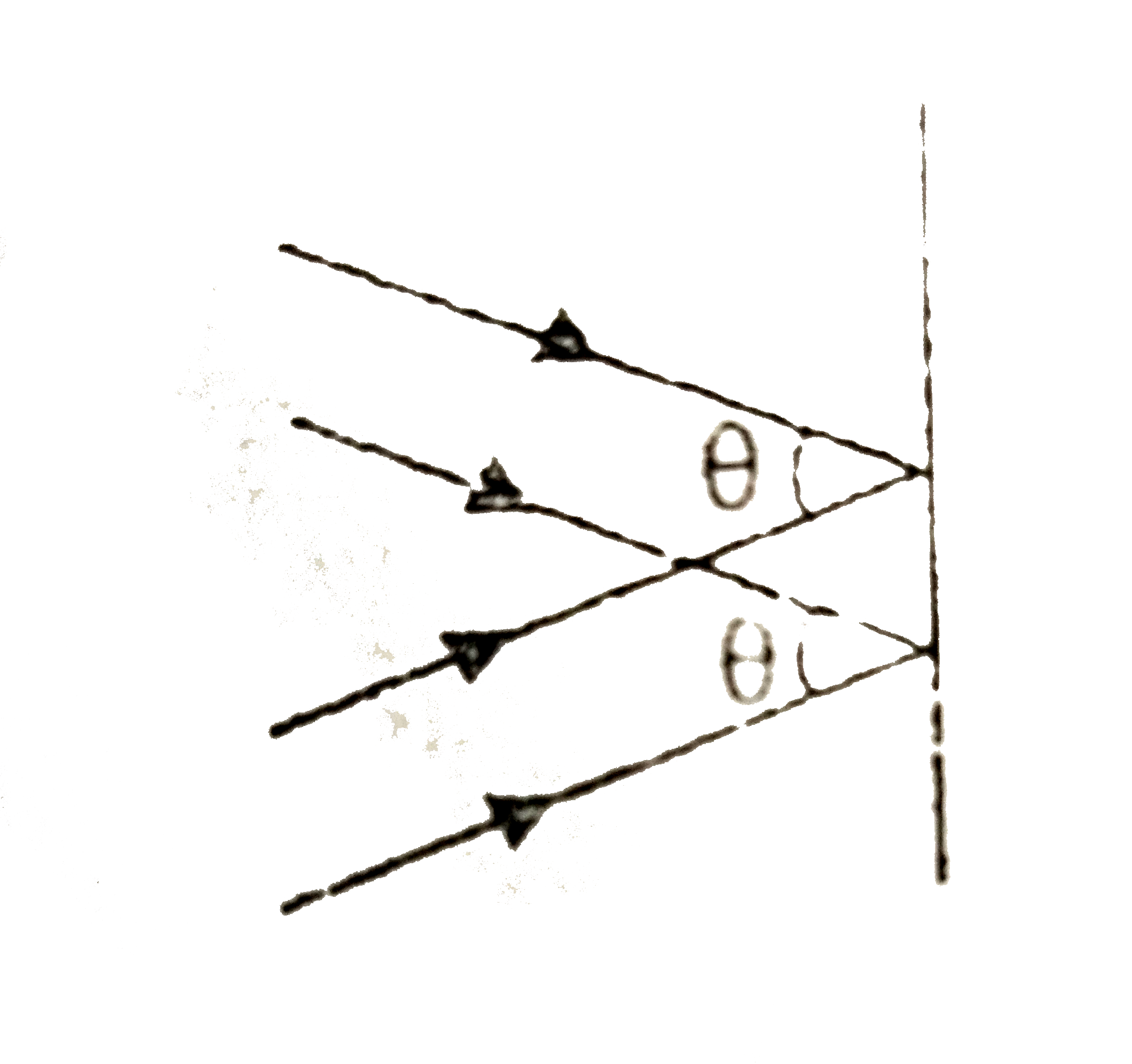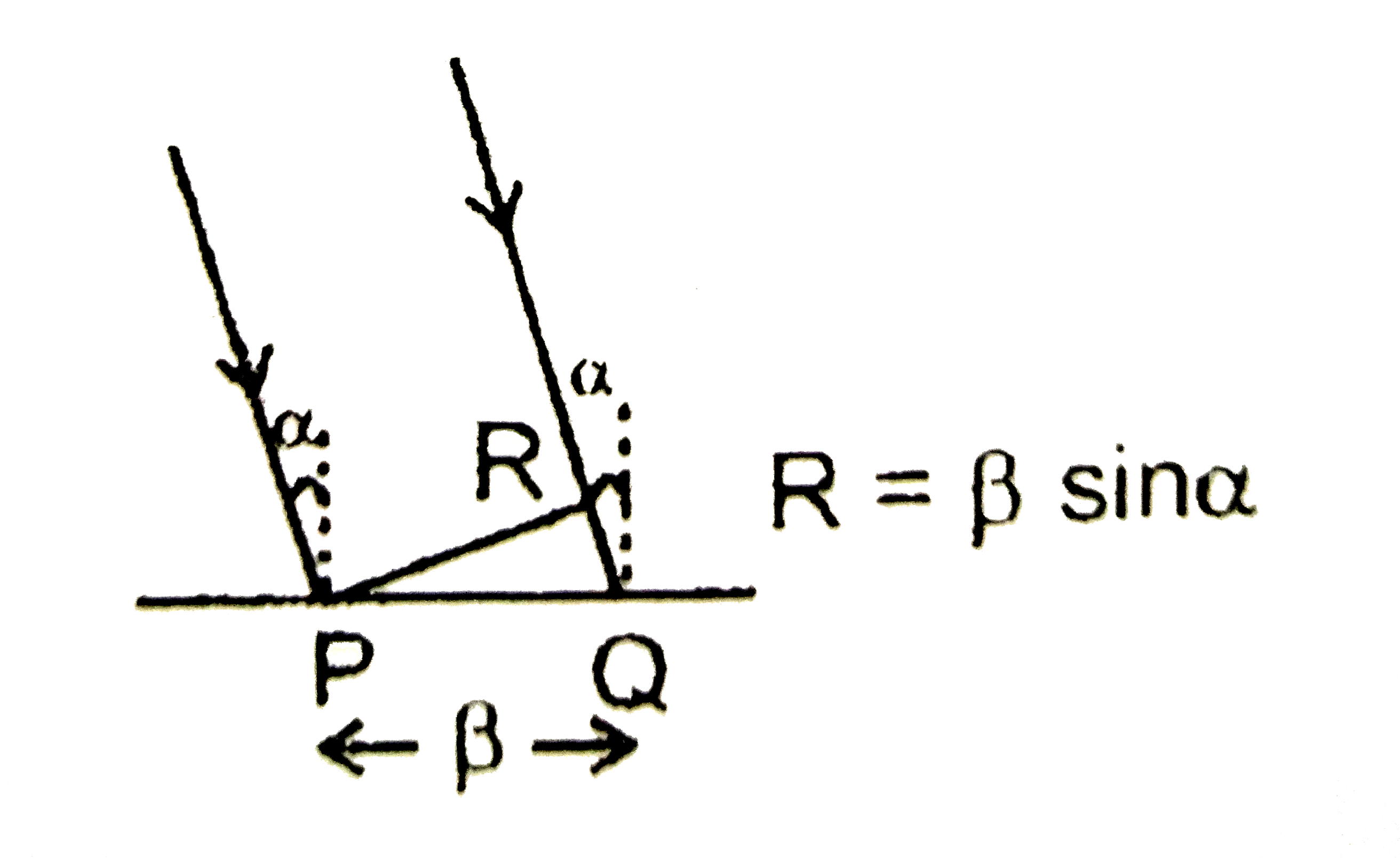Two parallel beams of light of wavelength λ inclined to each other at angle θ(<<1) are incident on a plane at near normal incidence. The fringe width will be :

λ2θ
2θθ
λθ
2λsinθ
The correct Answer is:C

R=βsinα
QR is the difference between the light reaching at Q and P respectively

PQ=βsinα
for given case α=θ2

For PQ to be one fringe. the path difference between the interfering light beams will change by λ while moving from P to Q
|path difference atP−path difference atQ|=λ
∣∣∣(βsin'θ2−(−βsin'θ2))∣∣∣=λ⇒2βsin'θ2=λβ=λ2sin(θ/2)
for near normal incidence sinθ~θβ=λθ

tanθ/2=d/2D(∴tanθ/2~θ/2)
∴θ=dD
β=λDd
β=λθ
Topper's Solved these Questions
- BOOK - RESONANCECHAPTER - WAVE OPTICSEXERCISE - Exercise-2 (Part-2)5videos
WAVE OPTICS
- BOOK - RESONANCECHAPTER - WAVE OPTICSEXERCISE - Exercise-2 (Part-3)5videos
WAVE OPTICS
- BOOK - RESONANCECHAPTER - WAVE OPTICSEXERCISE - Exercise-1 (Part-2)13videos
WAVE OPTICS
- BOOK - RESONANCECHAPTER - WAVE ON STRING EXERCISE - Exercise- 3 PART I19videos
WAVE ON STRING
Similar Questions
A parallel beam of light (λ=5000Å) is incident at an angle θ=30∘ with the normal to the slit plane in a Young's double slit experiment. The intensity due to each slit is I0. Point O is equidistant from S1andS2. The distance between slits is 1mm.
 View Solution
View SolutionA parallel beam of monochromatic light of wavelength 500 nm is incident normally on a rectangular slit. The angular width of the central fringe of Fraunhofer diffraction is found to be 60∘. Find the width of the slit in metre.
View Solution
Knowledge Check
- Question 1 - Select One
A ray of light of wavelength λ is incident on mirror at an angle of incidence 60∘. The wavelength of light after reflection will be
A2λB3λCλ/2Dλ - Question 2 - Select One
There are two plane mirrors. They are mutually inclined as shown in figure. S is a source of monochromatic light of wavelength λ. The reflected beam interfere and fringe pattern is obtained on the screen. If θ is small, the fringe width will be :
 Aλ/θB3λ/2θC2λ/3θDnone of these
Aλ/θB3λ/2θC2λ/3θDnone of these - Question 3 - Select One
When a beam of light wavelength λ is incident on the surface of a liquid at an angle ϕ , the reflected ray in completely polarized. The wavelength og light in the liquid medium is
AλTanϕBλTanϕCλCosϕDλSinϕ
Two plane mirrors are inclined at angleθ.A ray of light is incident on one mirror at an angle of incidence.i.The rayis refelected from this mirror,falls on the second mirror from where it is refleced parallel to the first mirror .What is the value of i,the angle of incident in term of θ?
View SolutionTwo plane mirror are inclined to each other at 90∘. A ray of light is incident on one mirror. The ray will undergo a total deviation of
View SolutionA parallel beam of light (λ=5000Å) is incident at an angle θ=30∘ with the normal to the slit plane in a Young's double slit experiment. The intensity due to each slit is I_0. Point O is equidistant from S1andS2. The distance between slits is 1mm.
 View Solution
View SolutionIf two plane mirrors are inclined at angle 0 to each other as shown, than angle of deviation of incident ray is
 View Solution
View SolutionTwo plane mirror are inclined to each other at 90∘. A ray of light is incident on one mirror. The ray will undergo a total deviation of
View Solution
